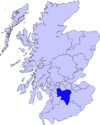
Lanarkshire, also called the County of Lanark, is a historic county, lieutenancy area and registration county in the Central Lowlands and Southern Uplands of Scotland. The county is no longer used for local government purposes, but gives its name to the two modern council areas of North Lanarkshire and South Lanarkshire.

Lanark is a town in South Lanarkshire, Scotland, located 20 kilometres to the south-east of Hamilton. The town lies on the River Clyde, at its confluence with Mouse Water. In 2016, the town had a population of 9,050.

East Kilbride is the largest town in South Lanarkshire in Scotland, and the country's sixth-largest locality by population. It was also designated Scotland's first new town on 6 May 1947. The area lies on a raised plateau to the south of the Cathkin Braes, about eight miles southeast of Glasgow and close to the boundary with East Renfrewshire.

Motherwell is a town and former burgh in North Lanarkshire, Scotland, United Kingdom, south east of Glasgow. It has a population of around 32,120. Historically in the parish of Dalziel and part of Lanarkshire, Motherwell is the headquarters for North Lanarkshire Council. Geographically the River Clyde separates Motherwell from Hamilton to the west whereas the South Calder Water separates Motherwell from Carfin to the north-east and New Stevenston and Bellshill towards the north.
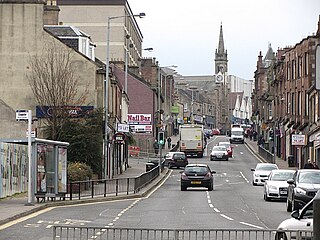
Wishaw is a large town in North Lanarkshire, Scotland, on the edge of the Clyde Valley, 15 miles (24 km) south-east of Glasgow city centre.

Carluke is a town that lies in the heart of the Lanarkshire countryside in South Lanarkshire, Scotland, 4+3⁄4 miles northwest of Lanark and 4+1⁄4 mi (7 km) southeast of Wishaw.
Central Scottish Omnibuses Ltd was a bus operating subsidiary of the Scottish Transport Group formed in June 1985 from Central SMT, and operated until July 1989 when it was merged with Kelvin Scottish to form Kelvin Central Buses.

Lanark and Hamilton East was a county constituency of the House of Commons of the Parliament of the United Kingdom, which was first used at the 2005 general election. It covered parts of the former Clydesdale, Hamilton North and Bellshill and Hamilton South constituencies, and it elected one Member of Parliament (MP) by the first past the post voting system.
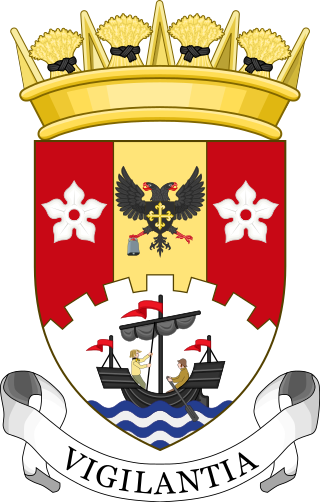
South Lanarkshire Council is the unitary authority serving the South Lanarkshire council area in Scotland. The council has its headquarters in Hamilton, has 16,000 employees, and an annual budget of almost £1bn. The large and varied geographical territory takes in rural and upland areas, market towns such as Lanark, Strathaven and Carluke, the urban burghs of Rutherglen, Cambuslang, and East Kilbride which was Scotland's first new town. The area was formed in 1996 from the areas of Clydesdale, Hamilton and East Kilbride districts, and some outer areas of Glasgow district ; all were previously within the Strathclyde region from 1975 but in historic Lanarkshire prior to that.
Forth is a village in South Lanarkshire, Scotland with a population of around 3,500 people. It is situated near Lanark, and stands at around 950 feet above sea level. It is on the A706 road between Lanark and Whitburn.
Braidwood is a small village near Carluke, in South Lanarkshire, Scotland. The medieval barony of Braidwood included the Tower of Hallbar.

Carluke railway station is a railway station on the West Coast Main Line (WCML) that serves the town of Carluke, South Lanarkshire, Scotland. The station is managed by ScotRail and is predominantly served by Argyle Line commuter trains running between Lanark and Glasgow Central. The station lies at the western edge of the town, and enjoys panoramic views of the Clyde Valley and beyond to the hills of Lanarkshire and Ayrshire.

Hamilton Townhouse is a building in Cadzow Street in Hamilton, South Lanarkshire, Scotland, which is operated by South Lanarkshire Council. It contains both the town's main public hall and public library, as well as various council departments including licensing and community learning. It is a Category B listed building.
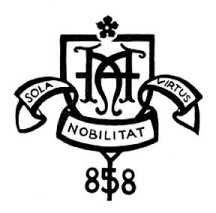
Hamilton Academy was a school in Hamilton, South Lanarkshire, Scotland.

Biggar High School is a secondary school located in the town of Biggar, South Lanarkshire.
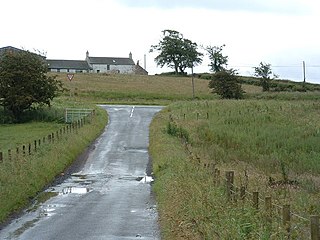
Chapelhall is a village outside the town of Airdrie in North Lanarkshire, Scotland. With house building, the distinction between Airdrie and Chapelhall is being eroded. Established as a small mining village in the 19th century, it now has population of around 6,560. Chapelhall is situated just off the M8 motorway 13 miles (21 km) east of Glasgow city centre and around 33 miles (53 km) west of Edinburgh. Chapelhall is also near to many of Lanarkshire's main towns, such as Bellshill, Coatbridge, Motherwell, Hamilton and Cumbernauld, as well as being around 3 miles (4.8 km) away from Airdrie town centre. The Eurocentral freight village/industrial estate is just a mile or so away and employs people from around Lanarkshire, Glasgow and West Lothian. The rail-freight village links with Grangemouth docks 28 miles (45 km) away,.

Uddingston Grammar School is a mainstream state school in Uddingston, South Lanarkshire, Scotland. It is one of 17 secondary schools operated by South Lanarkshire Council. Its motto is 'Virtute Crescam' which means 'May I grow in moral excellence'.
Thomas McAlpine was a Scottish nationalist politician.
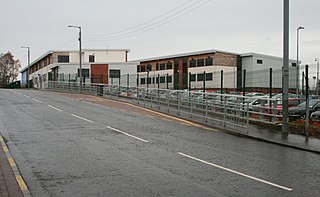
Lesmahagow High School is a non-denominational secondary school in Lesmahagow, South Lanarkshire, Scotland. The new school building opened in 2007. The current head teacher is Barbara Lee. The school has four deputy head teachers: David Robertson, Linda Wright, Pamela Docherty and Alistair Gray.
























